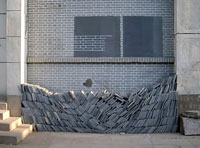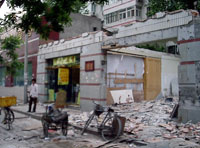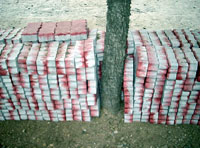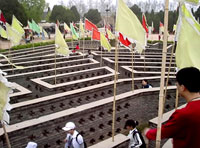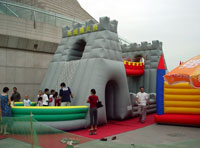Archive
About
Contact
Proposals
Blog
Window Shopping in Brick City
Daniel Malone >
-
Welcome to the Bricks
Written by Daniel Malone
Minimally Conscious / Unconscious
In 2002 I went to study at Beijing’s University of Language and Culture. I knew it was a university famous in China for teaching foreign language to Chinese, as well as teaching Chinese language (Mandarin or Putonghua - ‘the common tongue’) to foreigners, but not much else about what to expect.
I had visited mainland China once before and Hong Kong on several occasions, but knowing that this time I would be away for about six months I decided, en route in HK, to buy a cheap digital stills camera, my first, just in case I wanted a way to make work while there. However once I settled into studying I found the workload heavy, and the possibility of accessing any artistic communities in Beijing became more distant than distinct. I had started using my camera a lot though, but without any conscious intentions about what I was doing. One day, after I had been there about two months, a Chinese friend noticed the camera and, knowing I was an artist, asked to see some of the photos. As I flicked back over them for the first time, and she viewed them on the LCD, she voiced with some incredulity what was also running through my mind: “What are you taking photos of, they’re all just bricks?!”
She was right. Well to be fair there were a few other kinds of building materials, but I was still forced to consider how it was that they all fell into that space between her simultaneous question and answer. What was I photographing? Just bricks? So far I had relied on a kind of casually ‘dumb’ way of looking, consciously wanting, I think, to avoid working with a sense of what one should photograph of China, or more accurately, as a tourist in China. However, faced with the point blank specificity of the documents on my camera, I was forced to conclude that I was looking in a very particular and peculiar way. At first the conclusion seemed a little embarrassing. While it may not have been a recognisably prescribed way of looking at China I none-the-less recognised a look unconsciously informed by something particularly North American. Specifically U.S. Contemporary Art of the 1960s. Andre’s bricks, Judd’s boxes, LeWitt’s combinations, Smithson’s sites, Morris’s processes. What!? Minimalism?! Had I become afflicted by that insidious contemporary (art) disease causing fetishistic attraction towards dumb objects stacked or deployed in multiple. Did I buy a camera for something so inane? Well not exactly, because in fact Minimalism was never really about that until design magazines and art schools got their hands on it. My own abiding interest in it has concentrated on reclaiming the contemporaneous concerns of both its means of production, and its means of reception - a relationship to the body - labour and architecture respectively.
If I had wished to engage in Art Histrionics then my file names, given as visual triggers to keep track of the huge number of images I saved to disk, reveal a myriad of associations outside of just Minimalism. One can easily find Atget, Oldenberg, Duchamp, Matisse, even Chilcott’s, but why avoid taking the photographs of a tourist only to become a tourist of photography (or photography of art for that matter)? Why, unless one didn’t want to labour under the specificity of one’s given body, at a given time, in a given place, unless one wanted to travel as if in a dream.
Sleeping Dragon Awake
If instead, one used such an art history to enact a kind of displacement, for an awareness of one’s body in a present tense moment, in a kind of simultaneity between the above question and answer, production and reception. One might find it wedged with others’ bodies into the tight space of a crowded bus. The first time I took this bus, shortly after I arrived in Beijing, two things caught my eye. The first was the multitude of brick structures. Initially I was puzzled to see this material used so extensively, having a strong association in New Zealand as a very permanent and relatively expensive building material. This expense is of course tied to how labour intensive its use is - I realised that in China labour is the cheapest part of the equation, and the material itself, being essentially earth, is therefore a dirt cheap and favoured material. The second thing I noticed was the sheer amount of construction and the intense rate at which it was happening.
With China’s entry into the World Trade Organisation and growing pressure for diplomatic relations, not to mention the impending Beijing Olympics and the enormous Three Gorge’s hydro-electric power scheme, change appears ubiquitous, rapid, and even violent. For the first time in decades China has a new class in its class-less society, Nong Gong Ren (Farmer Workers) flock to Beijing, walking off their deserted farms in the west to take up the most menial tasks (and often lodging) on the multiplying construction sites.
The changes happening now in China are often spoken about in enthusiastic economic, even humanitarian, terms. A popular idea of this change, strongly equated with positivist notions of progress, is that China is ‘waking up’ after years of slumber. This metaphor is itself related to an older phrase; The Sleeping Dragon is a nickname for that most ancient and irreducible of symbols for China, The Great Wall, and now a popular nickname among economists for China itself.
Another phrase popularly employed by economic analysts, arguing the need for radical change but warning of instability, is that ‘China does not know evolution, only revolution’. This seems borne out in simple terms by all that one might presently see from any Beijing bus. Yet the space between this eternal return and the distance that the Sleeping Dragon snakes back through China’s history is not so easily reduced. Equal to the impact of hyperactive modernisation on my sense of China was the realisation on visiting The Great Wall that in fact The Great Wall does not exist. Ancient as it is, this most irreparable human scar on the surface of the planet has in fact never been a whole- a single entity. Instead it constitutes a series of simultaneous walls, over centuries joined, broken, and rebuilt, right up till the present day where annually hundreds of foreign tourists bemoan the fakeness of the ‘reconstructed’ designated tourist sites, while Chinese themselves don’t flinch from bright electric lights installed for night viewing.
The only flower I’d give to a policeman would be in a flower pot1.
On the same bus ride I had the un-singular experience of seeing something I thought I recognised as familiar in the urban terrain- my interest in graffiti had kept my eyes peeled since my arrival for local examples. Until now I had seen nothing, then suddenly, in one area a run of calligraphic gestures, all the same form, in a range of materials, some sprayed, some in inky splattered lines, on a range of walls. Could this be a lone tagger? I diligently copied down the character and its framing circle device to take home and decode by the rather laborious method of stroke order. My dictionary told me the hanzi (character) was pronounced chai, with a flat tone, and that it inferred the action of tearing down, dismantling. When I showed the ‘tag’ to my language partner he told me it was in fact short hand for Chai Hui. Chai Hui, he said, meant to demolish, but abbreviated in situ, with its ubiquitous framing circle, it signalled to those using a building that something else was to be built in its place. This is the character that makes up the logo/s of the bricks I’ve made. Objects with there own inherent return to earth built into them. I’d long before joked to my old friend Martin Poppelwell, the artist and ceramicist who assisted me in making these bricks, that the only ceramics I’d ever make would be bricks. When I thought of bricks I always thought of using them to throw through a window, to knock down a wall, before I thought of using them to build a wall.
- William Burroughs discussing 60’s counter-culture. The Job - Interviews with William S. Burroughs by Daniel Odier, originally published in French in 1969, republished in English 1974.
